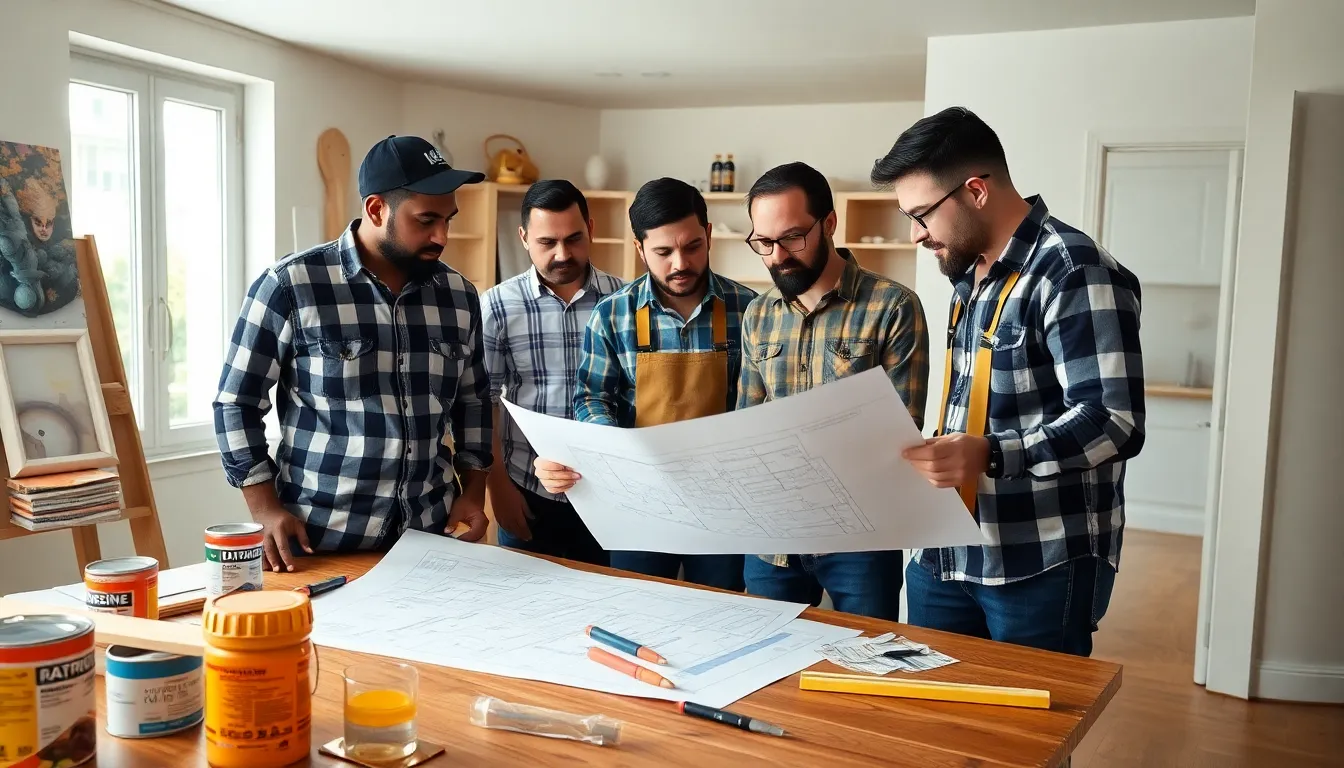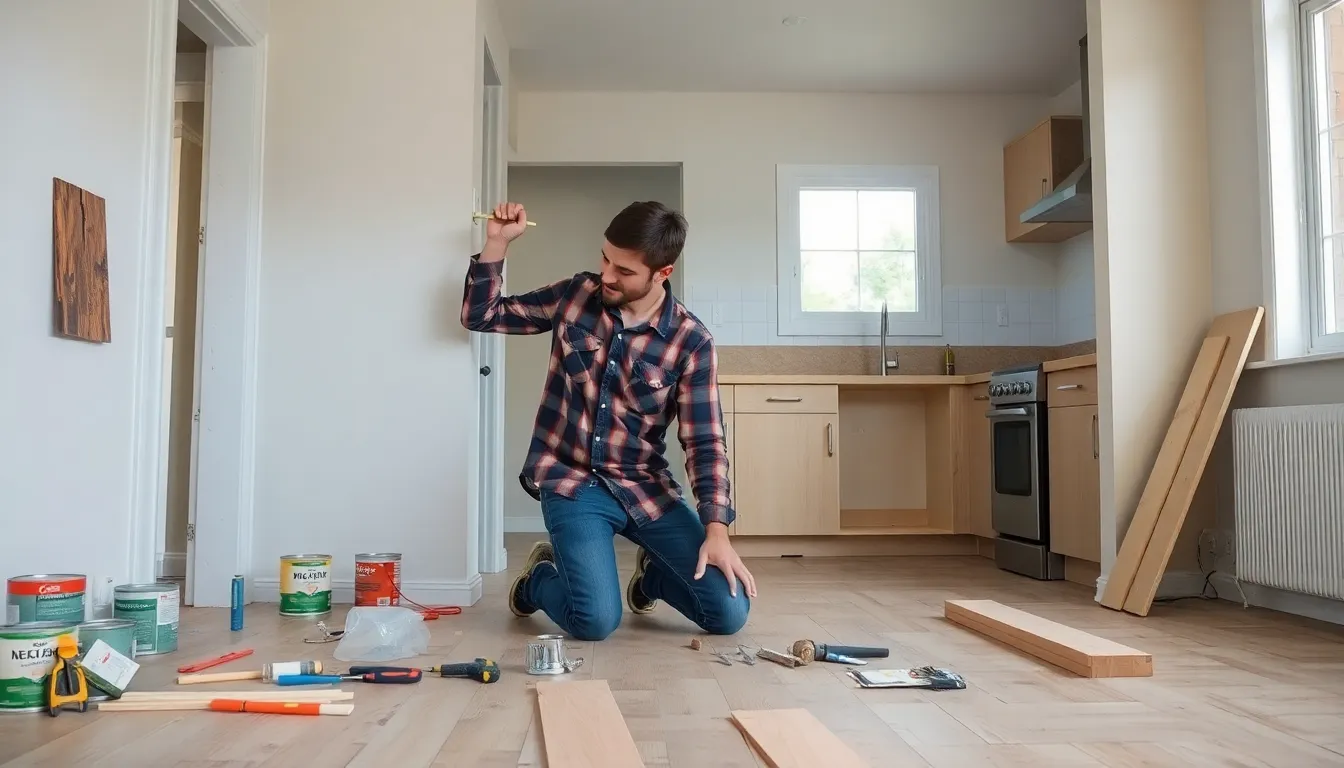Flipping houses can feel like a glamorous reality show where every nail and paint stroke brings in big bucks. But before diving headfirst into the renovation pool, it’s crucial to know the costs lurking beneath the surface. Spoiler alert: it’s not just a few cans of paint and some trendy light fixtures.
Table of Contents
ToggleUnderstanding House Flipping Renovation Costs
House flipping renovation costs encompass more than just materials. Labor fees represent a significant portion. Contractors charge varying rates depending on experience and project complexity. Homeowners often overlook permits and inspections, which can add several hundred to thousands of dollars.
The scope of renovations heavily influences expenses. Minor cosmetic upgrades generally require less investment than major structural changes. Kitchens and bathrooms usually demand considerable budgets due to plumbing and electrical work.
Understanding hidden costs proves essential for accurate budgeting. Unforeseen issues like mold or foundation problems may arise during renovations. Such surprises can derail timelines and inflate costs.
A detailed breakdown of common expenses can provide clarity.
| Expense Category | Average Cost Range |
|---|---|
| Labor | $50 to $150 per hour |
| Materials | $5,000 to $15,000 |
| Permits | $200 to $2,000 |
| Utilities | $100 to $300 per month |
| Inspection Fees | $300 to $600 |
Each expense category highlights the importance of thorough planning. Setting aside contingency funds can help manage unexpected costs. Flippers often find that a budget cushion of 10% to 20% protects against surprises.
Gaining an accurate estimate of total renovation costs increases the chances of profit. Investors should consult with professionals for precise assessments. Doing so helps clarify expectations and ensures a smooth renovation process.
Key Factors Influencing Renovation Costs

Understanding the factors influencing renovation costs is crucial for budgeting effectively. Several elements play a significant role in determining overall expenses.
Property Location
Location affects renovation costs significantly. Urban areas often entail higher prices due to labor and material demand. Geographic factors influence accessibility to contractors and suppliers, impacting timeline and expense. Renovating in regions with stricter building codes necessitates additional permit fees, which can increase costs. Proximity to amenities like stores, schools, and parks can enhance property value, justifying higher renovation budgets to align with market expectations.
Property Condition
Condition directly influences renovation costs. Properties in poor shape require more extensive work, including structural repairs and major system updates. Issues such as mold or outdated electrical systems often lead to unforeseen expenses. Older homes might necessitate compliance with modern safety standards, increasing fees. Assessing the general state of the property before starting renovations provides insight into budgeting needs, allowing for better project planning.
Scope of Work
Scope of work heavily impacts renovation budgets. Complex projects, like full kitchen or bathroom remodels, generally demand larger financial investments due to specialized labor and materials. Simple cosmetic updates, such as painting, often cost significantly less than structural changes. Each aspect of the renovation, from design choices to material selections, contributes to total expenses. Clearly defining the project’s scope before initiating can help establish realistic budgets and timelines, preventing overspending.
Common Renovation Expenses
House flipping involves various renovation expenses that homeowners must anticipate for accurate budgeting. Key costs include structural repairs, cosmetic upgrades, permits, and inspections.
Structural Repairs
Structural repairs significantly impact the renovation budget. Foundation issues can demand attention and may cost between $2,000 and $10,000, depending on severity. Roof replacements typically range from $5,000 to $15,000, influenced by materials and area size. Plumbing and electrical system updates also require funds; repair costs can reach $1,000 to $5,000, contingent on the issue’s complexity. Prioritizing these repairs ensures the property meets safety standards and maintains long-term value.
Cosmetic Upgrades
Cosmetic upgrades enhance a property’s appeal and can create substantial returns on investment. Kitchen renovations often account for $10,000 to $50,000, focusing on cabinetry, countertops, and appliances. Bathroom remodels typically range from $5,000 to $25,000, emphasizing fixtures, tiles, and layouts. Painting and flooring also contribute, with costs averaging $1,500 to $5,000 for both. Allocating resources for these upgrades attracts potential buyers and boosts resale value.
Permits and Inspections
Permits and inspections represent necessary expenses that often catch homeowners off guard. Obtaining permits can range from $100 to $2,000, depending on local requirements and project scope. Inspections, including structural and electrical assessments, may add $300 to $1,000 to the budget. Neglecting these costs can lead to fines or delays. Ensuring compliance with local regulations simplifies the renovation process and protects the investment.
Budgeting for House Flipping
Accurate budgeting plays a crucial role in successful house flipping. Properly assessing costs helps avoid financial pitfalls throughout the renovation.
Creating a Realistic Budget
Establishing a realistic budget requires evaluating all potential expenses. Begin by itemizing labor, materials, permits, and inspection fees. Contractors typically charge based on experience, impacting overall labor costs. Materials vary greatly; for example, kitchen renovations average between $10,000 and $50,000 depending on materials and design choices. Next, account for necessary permits, which can range from $100 to $2,000. Many homeowners overlook these costs, leading to budget discrepancies. Collaborating with seasoned professionals can provide valuable insights and ensure all expenses are covered. Prioritizing essential repairs versus cosmetic updates can also help streamline the budget.
Contingency Planning
Setting aside a contingency fund can safeguard against unexpected costs. Financial experts recommend reserving 10% to 20% of the total budget for unforeseen issues. Property conditions often reveal problems after renovations begin. Mold, plumbing issues, or structural concerns may emerge, resulting in costly repairs. Identifying these risks early in the planning process can prevent budget overruns. Adjusting the budget for worst-case scenarios enhances overall financial stability. Keeping a flexible approach while managing expenses ensures smoother operations. Developing a detailed timeline can also help track progress and expenses effectively.
Tips to Minimize Renovation Costs
Minimizing costs during renovations contributes to maximizing profits in house flipping. Understanding effective strategies can lead to significant savings.
DIY vs. Hiring Professionals
Choosing between DIY projects and hiring professionals has financial implications. DIY tasks can reduce labor costs but often require time, skill, and tools. Lack of experience might lead to mistakes, increasing expenses in the long run. Hiring professionals ensures high-quality work but involves higher upfront costs. Many contractors offer free estimates, providing homeowners with insight into potential expenses. Weighing the complexity of each task against one’s skill level helps determine the best approach for cost management. Prioritizing critical repairs may help in delegating aesthetic updates to amateurs.
Sourcing Materials Wisely
Sourcing materials efficiently directly impacts renovation budgets. Shopping at local suppliers or online marketplaces can reveal competitive pricing. Many homeowners find refurbished or surplus materials through networking, reducing costs further. Negotiating with suppliers for bulk purchases can lead to additional discounts. Researching alternative materials also opens up opportunities for savings without compromising quality. Utilizing local resources promotes community engagement while potentially lowering shipping fees. Prioritizing high-impact areas like kitchens and bathrooms for quality materials can enhance value, making strategic sourcing essential for budget management.
Navigating the world of house flipping requires a keen understanding of renovation costs. Homeowners must be aware of both visible and hidden expenses to avoid financial pitfalls. By meticulously planning and budgeting for all potential costs including labor permits and unexpected repairs they can enhance their chances of a successful flip.
Setting aside a contingency fund is a smart strategy to manage unforeseen issues. Additionally collaborating with experienced professionals can provide invaluable insights that lead to better decision-making. With thorough preparation and a clear focus on prioritizing essential repairs over cosmetic updates homeowners can maximize their investments and achieve profitable outcomes in their renovation projects.

